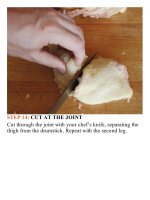The food lab better home cooking through science ( PDFDrive ) 229
Bạn đang xem bản rút gọn của tài liệu. Xem và tải ngay bản đầy đủ của tài liệu tại đây (133.51 KB, 2 trang )
HowtoMake
CREAMYVegetable
Soups
WITHOUTARECIPE
WhenIwasatotallygreencookwithmyfirstserious
restaurantjob,workingunderChefJasonBondatwhat’s
nowalandmarkBostonrestaurant,No.9Park,there
weremanymomentswhenIlearnedanewtechniqueor
perfectedanoldoneandsaidtomyself,“Holycrap,Ijust
madethis?”
But the very first was when Chef Bond taught me how to
makeacreamychanterellesoup(read:Campbell’screamof
mushroom soup on tasty, tasty crack), sweating aromatics,
sautéing mushrooms, adding a good stock, and pureeing it
allwhileemulsifyingthemixturewithfreshbutter.
Like any great vegetable soup, the end result was
something that tasted like a liquefied, purified, intensified
version of itself—this soup tasted more like chanterelles
than actual chanterelles. The magic lies in the way that
aromatic ingredients can bring out other flavors, as well as
the way in which liquids coat your mouth, giving more
direct contact to your taste buds and olfactory sensors, and
makingforeasierreleaseofvolatilecompounds.
Thesedays,therearen’ttoomanyvegetablesintheworld
that I haven’t made into a smooth, creamy soup, and there
areevenfewerthatI’venotloved,† but my experience has
taught me something: that first process of making a
chanterelle soup wasn’t really just a recipe for chanterelle
soup. It was a blueprint for making any creamy vegetable
soup.Youjustneedtobreakitdownintoitsindividualsteps
andfigureouthowtouniversalizethem.
Let’s say, for instance, that I’ve never made a smooth
carrotsoupflavoredwithgingerandharissa,butIreallylike
theidea.Here’showI’dgoaboutit.
Step1:PrepareYourMainIngredient
The simplest soups can be made by merely adding your
mainingredientsrawandsimmeringtheminliquidlateron.
Whenpreparingthistypeofsoup,allyou’vegottodoisget
your main ingredient ready by peeling it (if necessary) and
cuttingitintomoderatelysmallpieces.Thesmalleryoucut,
thequickeryoursoupwillcookdowntheline.
Therearetimeswhenyoumaywanttoboosttheflavorof
amainingredientby,say,roastingorbrowningit.Thisisan
especially effective technique for sweet, dense vegetables
like sweet potatoes and squashes, or brassicas like broccoli
orcauliflower,allofwhichintensifyinsweetnesswithsome
browning.To roast them, cut them into large chunks, toss
them with some olive oil, salt, and pepper, set them in a
baking sheet lined with aluminum foil or parchment paper,
and roast in a 375°F oven until tender, with their edges
tingedbrown.
This works in two ways. First, the process of
caramelization breaks down large sugars into smaller,









